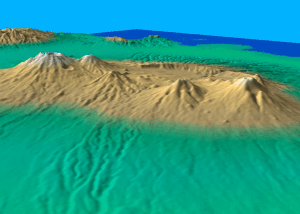Ijen
This article needs additional citations for verification. (November 2010) |
| Ijen | |
|---|---|
 Ijen caldera | |
| Highest point | |
| Elevation | 2,799 m (9,183 ft) |
| Listing | Spesial Ribu |
| Coordinates | 8°03′29″S 114°14′31″E / 8.058°S 114.242°E |
| Geography | |
 | |
| Location | Java, Indonesia |
| Geology | |
| Mountain type | Stratovolcano |
| Last eruption | 1999 |

The Ijen volcano complex is a group of stratovolcanoes, in East Java, Indonesia. It is inside a larger caldera Ijen, which is about 20 kilometers wide. The Gunung Merapi stratovolcano is the highest point of that complex. The name of this volcano resembles that of a different volcano, Mount Merapi in central Java, also known as Gunung Merapi. The name "Merapi" means "fire" in the Indonesian language.
West of Gunung Merapi is the Ijen volcano, which has a one-kilometer-wide turquoise-colored acid crater lake. The lake is the site of a labor-intensive sulfur mining operation, in which sulfur-laden baskets are carried by hand from the crater floor. Many other post-caldera cones and craters are located within the caldera or along its rim. The largest concentration of post-caldera cones forms an east/west-trending zone across the southern side of the caldera. The active crater at Kawah Ijen has an equivalent radius of 361 metres (1,184 ft), a surface of 0.41 square kilometres (0.16 sq mi). It is 200 metres (660 ft) deep and has a volume of 36 cubic hectometres (29,000 acre⋅ft).
In 2008, explorer George Kourounis took a small rubber boat out onto the acid lake to measure its acidity. The pH of the water in the crater was measured to be 0.5 due to sulfuric acid. [1]

Sulfur mining at Ijen

An active vent at the edge of the lake is a source of elemental sulfur, and supports a mining operation. Escaping volcanic gasses are channeled through a network of ceramic pipes, resulting in condensation of molten sulfur. The sulfur, which is deep red in color when molten, pours slowly from the ends of these pipes and pools on the ground, turning bright yellow as it cools. The miners break the cooled material into large pieces and carry it away in baskets. Miners must carry loads, which range from 70 kilograms (150 lb) to 100 kilograms (220 lb), up 200 metres (660 ft) to the crater rim and then several km (miles) down the mountain. Most miners make this journey twice a day. A nearby sugar refinery pays the miners by the weight of sulfur transported; as of September 2010, the typical daily earnings were equivalent to approximately $13 US. The miners often use insufficient protection while working around the volcano[2] and complain of numerous respiratory afflictions.
Media
Ijen and its sulfur mining was featured as a topic on the 5th episode of the BBC television documentary Human Planet. In the documentary film War Photographer, journalist James Nachtwey visits Ijen and struggles with noxious fumes while trying to photograph workers.
Gallery
See also
References
- ^ http://www.stormchaser.ca/Volcanoes/Kawah_Ijen/Kawah_Ijen.html Measuring the acidity of Kawah Ijen crater lake
- ^ http://www.boston.com/bigpicture/2010/12/kawah_ijen_by_night.html
External links
- Ijen Gallery
- Volcanological Survey of Indonesia
- Official website of Indonesian volcanoes at USGS
- The Adventures Behind Filming Ring of Fire
- Large photogallery from Kawah Ijen
- Sulfur mining in Kawah Ijen (The Big Picture photo gallery at Boston.com)
- More sulfur mining pictures at Ijen







